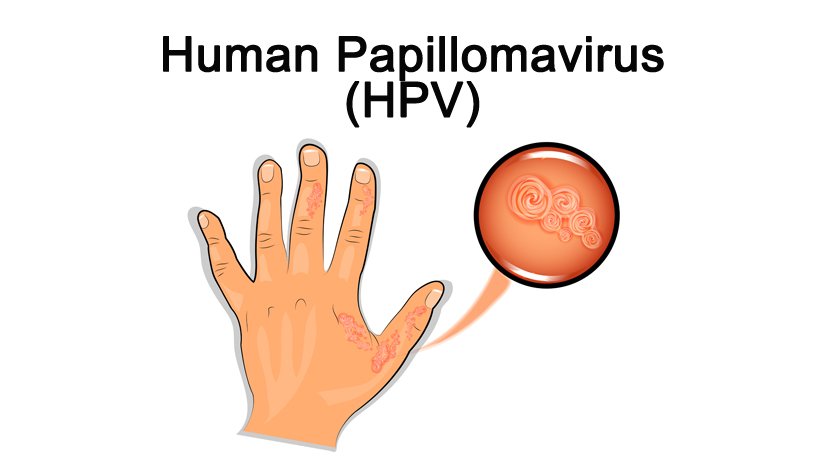
Despite the diversity of cancer-related risk factors, infections with bacteria and viruses are known risk factors for cancer. Worldwide, the most prominent infectious agents causing cancer are Helicobacter pylori (36.3%) and HPV (31.1%), followed by hepatitis B (16.3%) and C (7.1%). Despite lower numbers of cancer related to infection with other agents, including Epstein–Barr virus (EBV), human herpesvirus type 8, and human T-cell lymphotropic virus type 1 (HTLV-1) as well as three parasites: Opisthorchis viverrini, Clonorchis sinensis, and Schistosoma haematobium, are a cause of nearly 10% of all infection-mediated cancers.
HPVs belong to the family Papillomaviridae. The virions are non-enveloped and contain a double-stranded DNA genome. The genetic material is enclosed by an icosahedral capsid composed of major and minor structural proteins, L1 and L2, respectively. These viruses are highly tissue-specific and infect both cutaneous and mucosal epithelium. Based on the genomic sequence of L1, the gene encoding the principal capsid protein, over 200 HPV types have been identified and characterized5, with at least 14 high risk types which may cause cancer. Two HPV types (16 and 18) cause the most HPV-related cancers and about 70% of cervical cancers and pre-cancerous cervical lesions.
Importantly, HPV is mainly transmitted through sexual activity but people can also be infected by skin-to skin contact6. Notably, about 80% of people – both men and women – will get a HPV infection at some point in their lives. All sexually active persons can be infected with low- or high-risk HPV and usually become infected with HPV shortly after the onset of sexual activity. However, most often the immune system clears the virus, but for some, the infection persists and can lead to precancerous changes. In more detail, cells infected with high-risk HPV increase their proliferation rate and, over time, if not controlled by the immune system, they may form precancerous changes or a tumour. Factors like long-term usage of oral contraceptives, many pregnancies and smoking, a compromised immune system and coinfection with another sexually transmitted disease as well as the HPV type (high risk) may increase the risk of precancerous cervical cells leading to cancer2. Of note, nearly all cervical cancer cases are related to HPV infection. Nevertheless, HPV infection can be linked to other types of cancer, including anogenital cancer (vulvar, vaginal, anal, and penial), head and neck cancers (HNCs) or gential warts in both men and women.
Prevention, Screening & Diagnosis
Comprehensive cervical cancer control includes primary prevention (vaccination against HPV), secondary prevention (screening and treatment of precancerous lesions), tertiary prevention (diagnosis and treatment of invasive cervical cancer), and palliative care. Vaccines that protect against HPV 16 and 18 are recommended by the World Health Organization (WHO) and have been approved for use in many countries. All males and females ages 9–26 years should get the HPV vaccine. It is most effective when given at ages 11–12 years. The vaccine is given in two doses for males and females ages 9–14 years. Beginning at age 15 through age 45, three doses are required for full immunity. The HPV vaccine prevents HPV-related genital warts, most cervical, anal, vaginal, and vulvar cancers and reduces the risk of most HPV-related cancers of the throat and the penis. These vaccines consist of recombinant viral vaccine proteins containing purified virus-like particles for each virus genotype, thus they protect against different HPV types. Importantly, they are free of viral DNA so they are inactive and cannot infect cells. Three vaccines, Gardasil 4v (Merck&Co, Kenilworth, NJ, US), Gardasil 9v (Merck&Co, Kenilworth, NJ, US), and Cervarix 2v (GlaxoSmithKline Biologicals, Rixensart, Belgium), are now being marketed in many countries throughout the world – a quadrivalent, a nonavalent, and a bivalent vaccine, respectively.
Diagnostics for HPV Infections include:
- Pap smear
- DNA test
- Vinegar acid test
Treatment of HPV Infections at Antai Hospital
Here at Antai Hospital, our treatment includes using a local ablation with our proprietary Antai Liquid Medication 安太液 on the affected areas (cervical, vulvar, penile surface, etc.). Treatment is highly effective and with consistent treatment, you can fully recover within a 6 month period, full refund guaranteed. Upon recovery, we recommend you immediately get vaccinated with HPV vaccines that are available for an added measure of security.
3 Comments
I haven’t gone to the doctors to check if I for sure have hpv. I strongly believe I do because I started to get little bumps on my thighs that’s been slowly spreading. But as of now I only have one bump, it’s been sitting for a year already. I looked into it and I believe it is genital bumps of hpv.
Do get it diagnosed with your doctor if you are unsure, Mdm! And make sure to get vaccinated for HPV infections.
Where can I get HPV treatment? I am diagnosed with HPV16. Is the treatment available at Antai hospital Singapore? I am from India. Please let me know the cost of treatment also